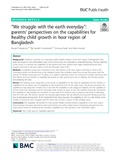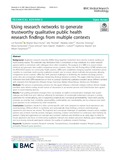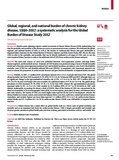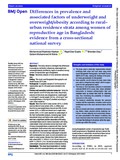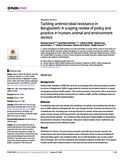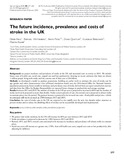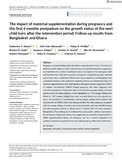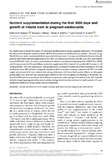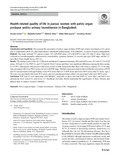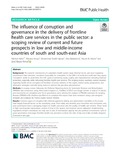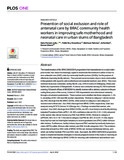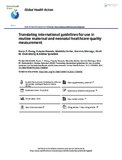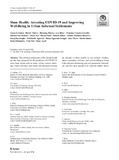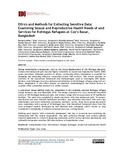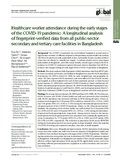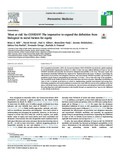Journal Articles (James P. Grant School of Public Health): Recent submissions
Now showing items 81-100 of 225
-
Factors associated with tobacco use among Nepalese men aged 15–49 years: Data from Nepal demographic and Health Survey 2016
(Elsevier, 2020-09)Background Tobacco is one of the leading causes of premature death around the world. In Nepal, tobacco kills 15,000 people every year. Men are also the primary users of tobacco. This study aimed to discern the prevalence ... -
“We struggle with the earth everyday”: parents’ perspectives on the capabilities for healthy child growth in haor region of Bangladesh
(Springer Link, 2020-01-31)Background: Childhood stunting is an important public health problem in the haor region of Bangladesh. Haor areas are located in the north-eastern part of the country and are vulnerable to seasonal flooding. The key ... -
Using research networks to generate trustworthy qualitative public health research findings from multiple contexts
(BMC, 2020-01-21)Background: Qualitative research networks (QRNs) bring together researchers from diverse contexts working on multi-country studies. The networks may themselves form a consortium or may contribute to a wider research agenda ... -
Global, regional, and national burden of chronic kidney disease, 1990–2017: A systematic analysis for the Global Burden of Disease Study 2017
(Lancet, 2020-02-13)Background Health system planning requires careful assessment of chronic kidney disease (CKD) epidemiology, but data for morbidity and mortality of this disease are scarce or non-existent in many countries. We estimated ... -
Differences in prevalence and associated factors of underweight and overweight/obesity according to rural–urban residence strata among women of reproductive age in Bangladesh: Evidence from a cross-sectional national survey
(BMJ, 2020-02-04)Objectives This study aimed to investigate the differences in prevalence and factors influencing underweight and overweight/obesity stratified by region of residence among women of reproductive age in Bangladesh. Design ... -
Tackling antimicrobial resistance in Bangladesh: A scoping review of policy and practice in human, animal and environment sectors
(PLOS ONE, 2020-01-27)Background Antimicrobial resistance (AMR) has become an emerging issue in the developing countries as well as in Bangladesh. AMR is aggravated by irrational use of antimicrobials in a largely unregulated pluralistic ... -
The future incidence, prevalence and costs of stroke in the UK
(Oxford Academic, 2020-01-20)Background we project incidence and prevalence of stroke in the UK and associated costs to society to 2035. We include future costs of health care, social care, unpaid care and lost productivity, drawing on recent estimates ... -
Mapping child growth failure across low- and middle-income countries
(Nature, 2020-01-08)Childhood malnutrition is associated with high morbidity and mortality globally1. Undernourished children are more likely to experience cognitive, physical, and metabolic developmental impairments that can lead to later ... -
Experiencing shame: An affective reading of the sexual and reproductive health and rights classroom in Bangladesh
(Taylor & Francis, 2020-01-11)This paper looks at how shame functions in the teaching of sexual and reproductive health and rights in the classrooms for 13–19 year-olds in secondary schools in Bangladesh. Using the theoretical framework of affect, the ... -
The impact of maternal supplementation during pregnancy and the first 6 months postpartum on the growth status of the next child born after the intervention period: Follow-up results from Bangladesh and Ghana
(Wiley, 2020-04)Pregnancy and breastfeeding make demands on maternal nutrient stores. The extent of depletion and the degree to which nutrient stores are replenished between pregnancies has implications for a mother's nutritional status ... -
Nutrient supplementation during the first 1000 days and growth of infants born to pregnant adolescents
(Annals of the New York Academy of Sciences, 2020-05)Few studies have evaluated the impact of nutritional supplementation among pregnant adolescents. We examined the effects of the Rang Din Nutrition Study (RDNS) interventions on children born to mothers <20 years of age. The ... -
Health-related quality of life in parous women with pelvic organ prolapse and/or urinary incontinence in Bangladesh
(Springer Link, 2020-07-01)Introduction and hypothesis We assessed the association of pelvic organ prolapse (POP) and urinary incontinence (UI), alone and in combination (POP-UI), and related factors with health-related quality of life (HRQOL) in ... -
Community-level environmental characteristics predictive of childhood stunting in Bangladesh - a study based on the repeated cross-sectional surveys
(Taylor & Francis, 2020-06-30)Coastal morphology makes Bangladesh vulnerable to environmental hazards and climate change. Therefore, environmental characteristics may shape population health, including child health. The prevalence of stunting among ... -
The influence of corruption and governance in the delivery of frontline health care services in the public sector: A scoping review of current and future prospects in low and middle-income countries of south and south-east Asia
(BMC, 2020-06-08)Background: The dynamic intersection of a pluralistic health system, large informal sector, and poor regulatory environment have provided conditions favourable for ‘corruption’ in the LMICs of south and south-east Asia ... -
Prevention of social exclusion and role of antenatal care by BRAC community health workers in improving safe motherhood and neonatal care in urban slums of Bangladesh
(PLOS ONE, 2020-07-08)The transformation of the BRAC MANOSHI programme from humanitarian to a social enterprise model, has made it increasingly urgent to enumerate the minimum number of door-to-door antenatal care (ANC) visits by community ... -
Translating international guidelines for use in routine maternal and neonatal healthcare quality measurement
(Taylor & Francis, 2020-07-13)Background: Improving facility-based quality for maternal and neonatal care is the key to reducing morbidity and mortality rates in low- and middle-income countries. Recent guidance from WHO and others has produced a large ... -
Slum Health: Arresting COVID-19 and Improving Well-Being in Urban Informal Settlements
(Springer Link, 2020-04-24)The informal settlements of the Global South are the least prepared for the pandemic of COVID-19 since basic needs such as water, toilets, sewers, drainage, waste collection, and secure and adequate housing are already in ... -
Ethics and methods for collecting sensitive data: Examining sexual and reproductive health needs of and services for Rohingya refugees at Cox’s Bazar, Bangladesh
(The International Journal of Information, Diversity, & Inclusion, 2020-07-13)During humanitarian emergencies, such as the forced displacement of the Rohingya diaspora, women and adolescent girls become highly vulnerable to sexual and reproductive health (SRH) issues and abuse. Although ... -
Healthcare worker attendance during the early stages of the COVID-19 pandemic: A longitudinal analysis of fingerprint-verified data from all public-sector secondary and tertiary care facilities in Bangladesh
(Journal of Global Health, 2020-12-01)Background The COVID-19 pandemic has overwhelmed hospitals in several areas in high-income countries. An effective response to this pandemic requires health care workers (HCWs) to be present at work, particularly in low- ... -
‘Most at risk’ for COVID19? The imperative to expand the definition from biological to social factors for equity
(Elsevier, 2020-08-06)First recognized in December 2019, the Coronavirus Disease 2019 (COVID19) was declared a global pandemic by the World Health Organization on March 11, 2020. To date, the most utilized definition of ‘most at risk’ for COVID19 ...

